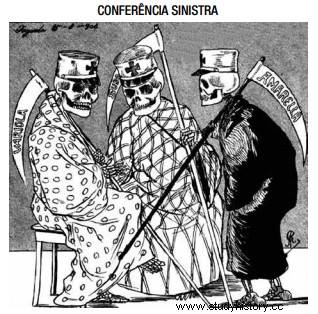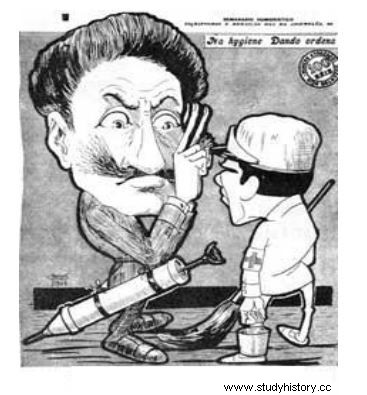Question 02 - UNESP 2014.2 - 1st phase - During the period of Rodrigues Alves' presidency (1902-1906), Rio de Janeiro went through an extensive reurbanization process. One of the objectives of this process was a) the democratization of the use of urban space, with the creation of leisure and popular entertainment areas. b) the stimulation of tourism and the organization of major events in the city, increasing the capture of financial resources. c) the systematic occupation of the hills, increasing the availability of areas for residence and provision of services. d) the improvement of urban hygiene and sanitation, with mandatory vaccination and the eradication of epidemics. e) the fight against violence and organized crime, which proliferated in the hills and in the central areas of the city.
Question 03 - VUNESP - 2013 - FUNDUNESP - Historiographer - At the beginning of the 20th century, the federal capital had a population of more than 800,000 inhabitants and was constantly plagued by outbreaks of yellow fever, smallpox, bubonic plague, malaria, typhus and tuberculosis. Concerned about the serious epidemiological situation in Rio de Janeiro, then-President Rodrigues Alves decided to put into practice the city's sanitation and hygiene plan, designed and coordinated by public health physician(A) Carlos Chagas.(B) Louis Pasteur.(C) Pereira Passos.(D) Oswaldo Cruz. (E) Martins Costa.
Question 04 - FGV - 2015 - TJ-RO - “Treaty of exchange of territories and other compensations between Brazil and Bolivia signed in the city of Petrópolis on November 17, 1903, approved by the National Congress on February 12, 1904, sanctioned by President Rodrigues Alves in a decree of February 18, with mutual exchange of ratifications on March 10, by which the boundaries between Brazil and Bolivia were established and the definitive incorporation of Acre into the national territory.” (Available at http://cpdoc.fgv.br/sites/default/files/verbetes/primeira-republica/ TRATADO%20DE%20PETR%C3%93POLIS.pdf) The treaty described in the text and the main reason for its sanction by the Brazilian government are, respectively:(A) Treaty of Madrid - expansion of the national territory; (B) Treaty of Petrópolis - interest in exploring rubber trees in the annexed territory; (C) Treaty of Ayacucho - mineral riches discovered in the Acrean territory; (D) Treaty of Petrópolis - high indemnity amount to be paid by the Bolivian government; (E) Treaty of Ayacucho - construction of the MadeiraMamoré railway.
Question 05 - UNITAU 1995 - During the Rodrigues Alves government (1902-1906), the vaccine revolt took place, which was contextualized:a) in the modernization and sanitation of Rio de Janeiro. b) in the modernization and sanitation of Brazil as a whole. c) in the fight against epidemic diseases promoted by the UN. d) in the reception of immigrants. e) in the opposition between the rural and urban sectors.
Question 06 - UERJ 2017.1 -

Charge da Revista Tagarela, published in August 1904, in which three diseases – yellow fever, bubonic plague and smallpox – they held a conference in the city of Rio de Janeiro.
The capital of the Republic cannot continue to be seen as the seat of a difficult life, when it has abundant elements to constitute the most notable center of attraction for arms, for activity and capital in this part of the world. RODRIGUES ALVES, President of the Republic, 1902-1906.Adapted from FIDELIS, C.; FALLEIROS, I. (Org.). On the tightrope of an umbrella:health in the thread of history. Rio de Janeiro:Fiocruz/COC; Fiocruz/EPSJV, 2010.
At the beginning of the 20th century, while the cartoon mocked one of the serious problems that affected the population of the city of Rio de Janeiro, the statement by then president Rodrigues Alves emphasized the concern with what could compromise the development of the capital of the Republic. In that context, a governmental action to promote such development and a result obtained were, respectively:(A) urban reform - qualification of the workforce (B) fight against unhealthy conditions - increase in immigration (C) expansion of the hospital network - control of birth rate(D) expansion of basic sanitation – eradication of poverty
Question 07 - FAMEVAÇO 2015/1 - Observe the charge represented by the image below. It is a caricatured illustration by the artist J. Carlos that explores historical facts from the period of Rodrigues Alves' government.

In hygiene giving ordersCharge by J. Carlos (1884-1950)Available at:http:/ /www.revistadehistoria.com.br. Access on:10/18/2014
The cartoon was intended to demonstrate, EXCEPT:
A) The syringe in the waist represented the weapon used in the mandatory vaccination decreed by Rodrigues Alves in his government.
B ) The time when vaccination was mandatory against smallpox.
C) Oswaldo Cruz's basic sanitation measures, implemented in the city of Rio de Janeiro.
D) The delivery of an award by the Minister of Health to a person, considering their role in the yellow fever eradication campaign.
FEEDBACK 01 - C02 - D03 - D04 - B05 - A06 - B
07 - D
